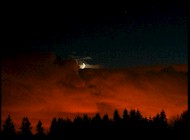|
By Joe Bucher
Full Moon or Dark Moon? Major and minor solunar periods? Which is best?
Does any of this moon mumbo jumbo make any real sense nor does it
actually work? These are legitimate questions asked by thousands of
anglers each year, and they deserve concrete answers backed up by some
bonafide data. Yet as much as pro anglers endorse the effectiveness of
moon charts and outdoor publications of every niche' continue to print
them, rarely does either source validate these solunar claims with data.
It's not hard to find a solunar table of some kind. Nearly every fishing
publication today publishes some kind of monthly solunar table, moon
chart, activity calendar, action graph, or other similar version. All of
these tables, charts, and calendars claim to predict daily feeding
activity of fish with accordance to moon and solar influences. Yet, I,
like so many other anglers, rarely find any consistent correlation with
most of these references.
Finally, back in 1976, when I got into the fishing guide business full
time, I really made it a point to compare my fishing catches to a number
of solunar charts. Once I started logging my catches on a daily basis I
developed a good data base. This finally put me in a position to compare
hundreds of muskies, and thousands of bass and walleyes on a daily,
monthly, and yearly basis to any printed solar/lunar reference. One of
my key entries was the time of day. I figured a daily
entry of fish activity would finally give me a mound of fishing data to
compare with the various solar/lunar references on a given day to day
basis. What followed convinced me that certain solar/lunar criteria
simply had little or no daily influence.
Basically, I became so frustrated and disappointed with
the lack of any real consistent correlation to most of the popular
magazine charts today that I gave up on them completely. They simply did
not work. I actually caught far more fish when they
weren't supposed to bite. And when good fish and game activity did
coincide, which was less than 10% of the time, it was plainly obvious
that it actually had much more to do with the local weather changes than
any predicted major or minor solunar period.
You would have thought that my accumulated research
would have cured me from ever looking at a solunar chart again, but it
did just the opposite. Why? Because I ended up discovering a certain
solar/lunar influence that really did work. In fact, it worked so well
that it was hard to believe at first. My daily fishing logs had surely
disputed the commonly accepted correlations, but they just as surely
pointed to indisputable evidence that a "certain" solar/lunar
factor was really important.
Yes, I had flipped 180 degrees on the entire solar/lunar
deal. I went from totally disbelieving to being totally convinced. In
fact, I eventually got to the point where I myself began to predict the
most probable daily, monthly and even yearly times when the biggest fish
were most apt to bite. And what's even more incredible, was that I was
right almost every single time! But perhaps what was even more
unbelievable to me was that everyone else had missed this simple but
really absolutely true key.
The real secret, I discovered, to solar/lunar influences
on a daily basis was nothing more than knowing when the sun and moon
rose and set on a 24 hour basis. That's right, it was simply a matter of
knowing, to the minute, when the sun came up and went down, and when the
moon came up and went down each and every day. My 21 year old fishing
log revealed without question that fish were active during a 90 minute
window surrounding each one of these four daily influences.
Now, I realize this sounds overly obvious, but I told you it would. Most
of the solar/lunar charts, tables and graphs you see depicted in today's
publications do not reveal nor coincide with these four
vital factors. 1) sun rise, 2) sun set, 3) moon rise, and 4) moon set.
Yet it doesn't take an astrologist to figure out how important the rise
and set of the sun and moon has to be.
It's certainly no secret that feeding movements of both fish and game
have been traditionally accepted as key during dawn and dusk -- this
correlates with sun rise and sun set. Moon rise and set is a bit more
tricky to key in on though since they can often occur at mid day or mid
night. Overcast weather can also make it impossible to see a moon rise
or set, and of course a dark/new moon is not visible to begin with.
The other "super secret" my logs revealed was
the predictable frequency of big fish catches during the peak moon
phases of full and new moon. Specifically, a lot more big muskies,
walleyes, and bass were taken right on the scheduled calendar day of
both the full or new (dark) moon peak, and continued for a three to five
day stretch afterwards. In other words, if the full moon peak is on June
10th, June 10 thru 15 have great potential for trophies.
Backing up a bit, the four daily factors previously
discussed (the rise and set of both the sun and moon) inside each one of
these predictable monthly moon peaks (four days on the back side of the
full or new moon) further nails it down. In other words, you want to
plan your fishing trips to hit the peak of the full or new moon. Then
you want to be on your favorite big fish spots during the daily rise and
set of both the sun and the moon.
Finally, my logs revealed a third factor that really
adds impact to this entire solunar secret. That unpredictable third
influence is local weather. Whenever a local weather change coincides
with the daily rise or set of either the sun or the moon, during a peak
monthly moon period, big things happen in bunches. Big
things meaning big fish. For example, give me a severe
summer T-storm right at sunset, and just before moon rise during the new
moon period and it's almost a sure bet that that I'm going to bag big
muskies or the year's biggest catch of lunker walleyes. Or just as good
-- put me on a steep rocky shoreline with some spawning ciscoes right at
the start of a snow storm in the late fall just after sunrise and right
before moon set during a full moon period. Big muskies, big pike, big
walleyes and big lakers will be snappin'.
Could there be a fourth factor? Absolutely. In fact,
there might even be a 5thor 6th. However, an easy-to-detect 4th factor
of influence that adds even more impact to an already good situation is
a change in the photoperiod, or laymen's terms -- a change in season.
Photoperiodism is actually the measured ratio of daylight to darkness.
The most drastic changes in the photoperiod occur in the spring and
fall, but mini-differences are detected inside all seasons which are
quickly detected thru their eyes and transmitted to their pituitary
gland. The responses to these changes in the photoperiod trigger sexual
responses such as reproduction and the development of eggs. This, in
turn, also triggers increased movement and feeding binges by normally
less active trophy fish.
I do realize how controversial my comments on solunar table validity may
seem to some, but the facts speak for themselves. My data clearly points
to sun rise, sun set, moon rise and moon set as The most important
factors. The simple rise and set of both the sun and moon has far more
impact than any other daily sun or moon position. That is, bar none, the
single most important daily triggering factor of both fish and game.
Monthly peaks in both the full and new moon are a second factor
definitely worth considering. When fish of all sizes are feeding
infrequently due to a prolonged streak of bad local weather conditions,
that small "window" of three to four days right after the
actual moon peaks, full or new, may be the
only time that the largest fish of any species is truly cacheable.
Fishing during the daily rise or set of the sun and moon during these
key monthly moon phases is paramount.
Weather is also a legitimate third factor, and helps to elevate the
impact of the daily rise and set of the sun or moon. It further elevates
the entire realm of big fish possibilities when all three factors happen
at relatively the same time. A changing weather pattern combined with a
good monthly moon phase and rise or set of either sun or moon can
activate some major movement from big fish.
If all of these things happen during a good photoperiod, look
out! This is when the biggest fish of the year are generally
caught. If your serious about taking such a fish, I'd suggest you start
really paying attention to the real scoop on moon phases! Trust me --
thousands of entries in my fishing logs
can't be wrong. This stuff really works!
|







